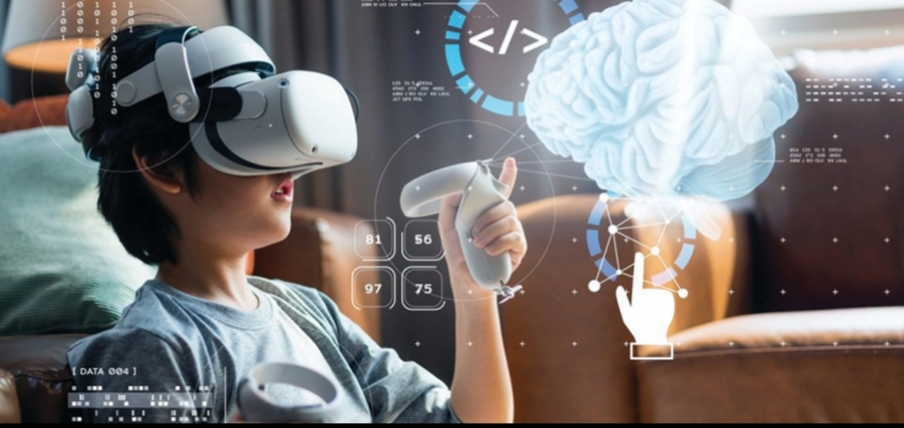Introduction:
In the technological Landscape, the amalgamation of Augmented Reality (AR), Virtual Reality (VR), and Mixed Reality (MR) stands as a testament to human ingenuity. These immersive technologies have transcended the boundaries of traditional human-computer interactions, redefining the way we perceive and engage with the digital and physical realms. This article delves into the realms of AR, VR, and MR, exploring their unique attributes, applications, and the role of artificial intelligence (AI) in shaping the future of these transformative technologies.
Understanding Augmented Reality (AR) and Virtual Reality (VR):
Augmented Reality (AR) enriches our real-world experience by superimposing digital information onto our surroundings. This technology enhances user perception and interaction with the physical environment, finding applications across diverse industries like gaming, education, healthcare, and manufacturing. In gaming, AR introduces immersive elements into the real world, creating interactive and engaging experiences. Educational applications leverage AR to bring subjects to life, overlaying educational content onto textbooks or real-world objects. In healthcare, AR aids surgeons with real-time data during procedures, while in manufacturing, it improves efficiency through remote guidance for field technicians.
Conversely, Virtual Reality (VR) transports users into a fully digital environment, effectively isolating them from reality. Widely adopted in gaming, VR offers an unparalleled experience, immersing users in virtual worlds free from geographical constraints. VR is also extensively utilized in simulation training and virtual tourism, providing a realistic and controlled environment for learning and exploration. These technologies showcase the dynamic evolution of immersive experiences, each catering to distinct user needs and reshaping how we perceive and engage with our surroundings.
The Intersection: Mixed Reality (MR):
Mixed Reality (MR) is the fusion of Augmented and Virtual Reality (AR/VR), seamlessly blending the physical and digital realms. With MR, users experience an interactive environment where real and virtual elements coexist, elevating immersion. This innovation holds transformative potential, particularly in architecture, engineering, and design. MR enables users to manipulate virtual objects within their real-world context, revolutionizing these industries. This convergence enhances spatial understanding and collaborative possibilities, offering a new dimension of interaction and creativity. The applications of MR extend beyond entertainment, promising a future where our physical and digital experiences harmoniously coalesce for more dynamic and practical engagement.
Applications of AR, VR, and MR:
Education:
AR brings textbooks to life by overlaying 3D models and interactive content, enhancing the learning experience.
VR transports students to historical events or distant planets, providing a hands-on and immersive educational journey.
MR enables collaborative learning experiences, where students can interact with virtual objects in a shared physical space.
Healthcare:
AR assists surgeons with real-time data during procedures, improving precision and reducing errors.
VR is used for exposure therapy in treating phobias and PTSD, offering a controlled and immersive environment for therapeutic interventions.
MR facilitates medical training by allowing practitioners to interact with virtual patients in a realistic setting.
Gaming and Entertainment:
AR enhances mobile gaming with location-based experiences, like Pokemon GO, where virtual creatures appear in the real world.
VR provides an unparalleled gaming experience, immersing players in virtual worlds that respond to their movements.
MR introduces a new dimension to gaming by merging virtual elements with the player’s physical surroundings.
Enterprise and Manufacturing:
AR assists field technicians with real-time information and remote guidance, improving efficiency and reducing downtime.
VR is used for virtual prototyping and design reviews, allowing engineers to visualize and manipulate 3D models.
MR enhances collaboration in remote work scenarios by creating virtual meeting spaces where users can interact with digital content.
The Role of Artificial Intelligence (AI):
Artificial Intelligence plays a pivotal role in advancing AR, VR, and MR technologies, enhancing their capabilities and making them more intelligent and adaptive. AI algorithms contribute to:
Object Recognition:
AI-powered computer vision enables AR applications to recognize and interact with real-world objects seamlessly.
VR simulations benefit from AI-driven object recognition, creating more realistic and dynamic virtual environments.
Personalization:
AI algorithms analyze user behavior and preferences to personalize AR content, ensuring a more engaging and relevant experience.
VR experiences become more tailored through AI-driven adaptive learning, adjusting the virtual environment based on user interactions.
Gesture and Voice Recognition:
AI enhances the interactivity of AR and VR by enabling gesture and voice recognition, allowing users to control virtual elements intuitively.
MR applications leverage AI to understand and respond to natural gestures and vocal commands in real-time.
Predictive Analytics:
AI-driven analytics in MR applications predict user actions, enabling proactive adjustments to the virtual environment for a smoother and more natural experience.
Challenges and Future Prospects:
While AR, VR, and MR have witnessed rapid advancements, significant challenges persist, including hardware limitations, user acceptance, and ethical considerations. The hardware constraints, such as the need for powerful devices, hinder widespread adoption. Achieving universal user acceptance remains a challenge due to concerns about privacy, security, and potential societal impacts. Ethical considerations, such as the responsible use of AI in these technologies, raise questions about data protection and algorithmic biases. However, ongoing research and development, coupled with the integration of AI, offer promising solutions. As technology evolves, addressing these challenges will pave the way for seamless integration into our daily lives. The future envisions a harmonious coexistence where AR, VR, and MR become integral parts of our societal fabric, providing enriching and inclusive experiences across various domains.
Conclusion:
The convergence of Augmented Reality (AR), Virtual Reality (VR), and Mixed Reality (MR) marks a paradigmatic shift in our digital interaction. Across education, healthcare, gaming, and enterprise, these immersive technologies are reshaping industries and unlocking unprecedented possibilities. The evolving synergy with Artificial Intelligence (AI) promises to amplify their impact, ushering in an era where distinctions between the physical and virtual worlds blur. This symbiosis between AR, VR, MR, and AI paves the way for a highly interconnected and immersive digital future, where technological boundaries dissolve, creating a transformative landscape for diverse applications and experiences.
